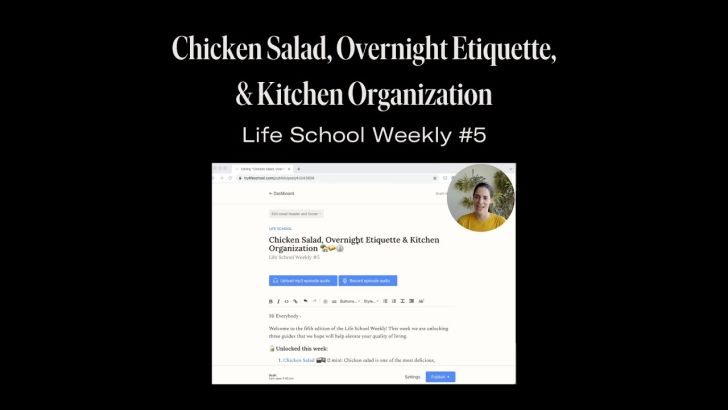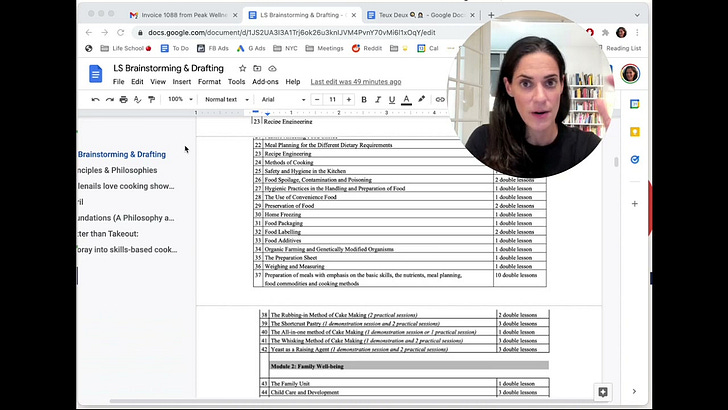This lesson is 899 words, a 3 minute and 35 second read time. It is the third lesson of The Weekly Kitchen Cleaning Routine.
📍 Introduction
There are some great benefits to having a clean and well-organized fridge. A big one is being able to find an ingredient while cooking. Digging around your fridge for something mid-cooking can lead to items scorching.
Another advantage is reducing forgotten items. Lost ingredients & leftovers often spoil, leading to financial and environmental waste.
Is your fridge a jumble? Fret not! Here are some tips and tricks to help you get spiffed up fast.
⚙️ Gear
All-purpose cleaner (or dish soap)
Cleaning cloth
Fridge thermometer (optional)
✅ Instructions
Basic Cleaning
Review fridge for spoiled foods. Remove and toss/compost.
Spot clean with a warm, damp cloth & all-purpose cleaner as necessary.
Organize the refrigerator to your preferences.
Deeper Cleaning (2x/year+)
Remove all items from the refrigerator.
Wash bins and shelves in the sink with hot soapy water.
Wipe down other surfaces with a warm, damp cloth & all-purpose cleaner.
Wipe dry.
📝 Notes, Tips, and Tricks
General:
The less food you waste, the more money you save. Organized home chefs often waste <5% of ingredients.
Expiration & sell-by dates are subjective. A quick sniff test or visual review is most reliable. If something is rancid or rotting, your nose & intuition will know it.
When in doubt, throw it out.
Cleaning & Keeping Clean:
An open box of baking soda can help absorb odors. Replace every ~3 months, and use it for cleaning (e.g., scrubbing down the sink).
To make for easy drawer cleaning, place paper towels along the bottom.
Ensure everything that goes into the fridge is clean (e.g., wipe off drips on rims and sides of bottles)
Temperature Control:
The ideal fridge temperature range is between 35 and 38°F. Above 40°F is the "danger zone." A refrigerator thermometer (typically <$10 at a hardware store) is helpful for monitoring.
Every time you open the fridge door, warm air rushes in. Don't leave the door open for too long as it enables certain items to degrade faster (e.g., dairy).
Fridge & freezer compartments are generally cooled by the same system. They do this by sharing air between the two. If you leave something stinky in the fridge (e.g., garlic), the ice in the freezer could end up tasting like it. Cover items accordingly.
Keep your fridge about ¾ full - enough to "hold the cold" but also allowing room for air to circulate.
Organizing & Storage:
If you tend to forget what's inside your tupperware, use some painter's tape and a sharpie to label it.
Store items you want to consume faster (e.g., cut vegetables, leftovers) at eye level & in front (e.g., top & middle shelves). Consider hiding items you want to consume less of (e.g., cheese, treats) in harder-to-reach areas (e.g., drawers). For a controversial take on this, check out this TikTok.
If you have multiple items of the same kind, place the new items behind older ones (so you use up older items first).
Organizer bins (like these) can help designate spaces for items. They also make it easier to pull groups of things out simultaneously (e.g., frozen fruits).
Glass containers make for easier viewing & faster identification.
Eggs are best left in the carton to reduce their absorption of fridge odors.
Keep milk near the back of the fridge (where it's coldest).
Meat & poultry are best stored low in the fridge to reduce their chance of dripping on other items. If there are drips, place items in a bowl or on a plate.
High humidity crisper drawers work by permitting less air to circulate (thereby drawing out less moisture). They are best for leafy greens, which often wilt, as well as strawberries and citrus.
No high humidity drawer? You can mimic the effect by wrapping lettuce in a wet paper towel & storing it in a plastic bag. Produce bags from the grocery store work well for this - as well as reusable silicone ones. Leave room for some airflow, though, or it can mildew.
Low humidity drawers are great for fruits. Fruit emits ethylene gas which promotes ripening and spoilage. With low humidity, there is better ventilation.
To extend the life of fruit, consider purchasing a "produce freshness saver" like this one. To use, place it inside the drawer with the fruit. It absorbs the gas, slowing ripening.
Conversely, to speed up ripening, remove fruits from the fridge. To speed up ripening even more, concentrate the gas emissions (e.g., put fruit inside a paper bag with apples).
If you haven't used a condiment in a few months, just toss it. It's taking up space and cluttering your fridge.
Every month review items in the freezer and identify those you can use up (e.g., frozen meat, frozen leftovers). Freezers don't stop time entirely. See the Freezer Storage Reference Guide for more information.
🎓 Further Study:
Freezer Storage Reference Guide [Life School]
Freezer Organization and Care [Life School]
How to Hack Your Freezer [Life School]
How to Make Produce Last Longer & Reduce Waste 🎬 [Sweet Simple Vegan]
What to Store in Your Refrigerator Humidity Drawers [Kitchn]
📢 Announcements & Requests:
Should we launch a community? Answer our four-question survey here.
Want to weigh in on our content roadmap? Vote and request lessons here.
Discussion Question: Do you have any tips or tricks for keeping the fridge organized? Leave a comment below.
Premium content is coming soon. Subscribe here.










